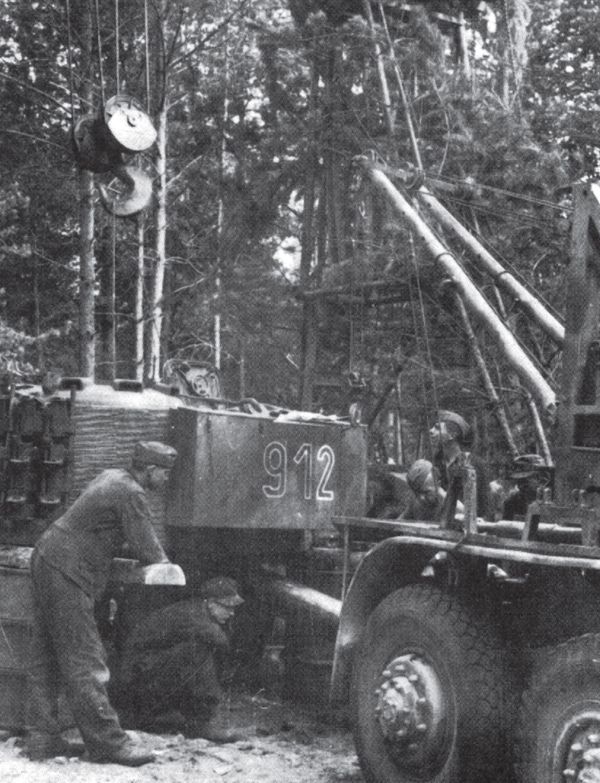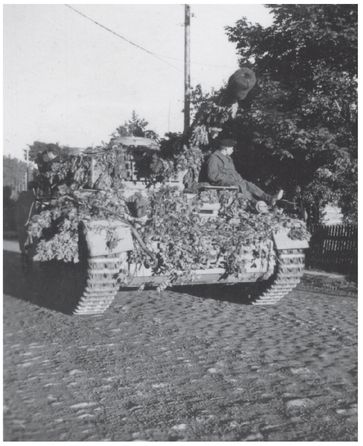Authors: Norbert Bacyk
Warszawa II (12 page)

A Soviet 8.2 cm calibre mortar, model 1938, in the vicinity of Warsaw, August 1944. (WAF)


A Tiger tank under repair, serial nr. “912” from the 9th SS-Panzer-Regiment 3 “Totenkopf”, the Slupno region, August 1944. (Bundes-Archive)
This order began to be implemented almost immediately after it had been given. Fallschirm-Pz. Gren. Rgt. 2 “Hermann Göring” â which had only just now completed its consolidation and had not participated in the fighting in Praga â was sent towards the frontline troops. A panzer grenadier battalion from the Panzer-grenadier-Regiment 74, supported by a column of PzKpfw IV tanks, left on the same day through a Warsaw in violent revolt. The Germans' objective was to makes their way into the city, in which they were only partly successful and only at a heavy cost of lives.
The rest of General Källner's division and the “Hermann Göring” left the battlefield a short while later. General von Vormann decided to continue pursuing the battle outside Praga until at least August 5. In this way, he could capitalize on the successes he had thus far achieved, thanks to the formidable consolidation of combat strength. On August 4, an attack was launched from the WoÅomin area in a southerly direction against a Kampfgruppe from the 19th Panzer-Division and “Hermann Göring.” The Germans attacked the 8th Tank Guards Corps' position (60th Tank Guards Brigade, 59th Tank Guards Brigade, and the 28th Mechanised Guards Brigade) outside of Okuniew along both banks of the DÅugas River. In carrying out this attack they sought to drive yet another Soviet tank corps away from the suburbs of Praga. The difficult terrain and the strong defences hindered the attack. The I Panzer-Regiment 35 and the II Panzergrenadier-Regiment 12, for example, could not force a break in the 59th Tank Guards Brigade's position in the area around Zabraniec, though they spent an entire day in the attempt. At this same time-point, troops from the 3rd SS-Panzer-Division “Totenkopf ” began an offensive against Okuniew from the east through Pustelnik and MichaÅów. This attack, despite some initial success outside MichaÅów, was also bloodily thrown back. The battles conducted by Becker's division received no support from units of the 5th SS-Panzer-Division “Wiking” for the reason that, on August 4, this force had been drawn into the fighting outside StaniÅawów by the 77th Rifle corps from the Soviet 47th Army. Despite a dearth of successes on this the 4th day of August, that very day the Wehrmacht reported 76 Soviet tanks as having been destroyed (this figure probably reflects the total number of wrecks recorded outside WoÅómin).
Three captured Sd Kfz Panther ausf A's in working condition east of Warsaw in August are ordered into action around Praga under the command of Lieutenant Sotnikov. (Leandoer & Ekholm archive)


A well camouflaged tank, model PzKpfw IV Sd Kfz 161/2 Ausf. H, from the II Panzer-Regiment 35. The photo is probably taken during fighting in the vicinity of Radzymin during the first ten days of August 1944. (MWP)
A destroyed tank, model PzKpfw IV Ausf. H, from the SS-Panzer-Regiment 3 “Totenkopf”, Radzymin region, August 1944. (Janusz Ledwoch)

On August 5, the 19th Panzer-Division's began a westward march across the bridges of Warsaw and Modlin. The Soviet 47th Army's (less the 125th Rifle Corps) sudden attack against
the 5th SS-Panzer-Division “Wiking,” which had begun along the road towards Siedlce, forced the German side to withdraw both Waffen-SS Panzer Divisions that same day from the battles directed against the 8th Tank Guards Corps. They now made battle-ready and manned defensive positions between StanisÅawów and the Liwiec River. Left to oppose the 8th Tank Guards Corps in this tank battle, there now remained only sections out of Division “Hermann Göring” plus the Kampfgruppe from the 4th Panzer-Division. Together, they launched an attack to the north and northeast against the 8th Tank Guards Corps' positions outside of Okuniew. The 4th Panzer-Division noted only insignificant territorial gains, while the Luftwaffe's grenadiers were wiped out under intense fire from positions manned by the Soviets at the start of battle. General Popov, who still had considerable combat resources at his disposal, organized a counter-attack with the aim of retaking their original positions. Thanks to his successes (the 4th Panzer-Division lost 11 tanks), by evening, the front was back to the situation as it had been on August 4. And since at the same time this was taking place, General von Saucken received orders to immediately re-deploy Division “Hermann Göring” to Magnuszew, he had also lost any opportunity of carrying out further attacks on the enemy.

The commander of the 4th Panzer-Division, General Betzel, in an armoured transport vehicle, Sd Kfz 251/6. The photo is probably taken during fighting in the vicinity of Radzymin during the first ten days of August 1944. (MWP)
A Soviet artillery, tracked tractor, model JA-12, tows a 12 cm howitzer 1907/30 toward the front, summer of 1944. (WAF)

On August 6, the remaining German units withdrew from the area around Okuniew and were replaced by the 73rd Infantry-Division and the 1131st Grenadier-Brigade. Still positioned outside Zabraniec was the artillery-reinforced Panzergrenadier-Regiment 12, which the 4th Panzer-division I Panzergrenadier-Regiment 33 attached themselves to. Tanks from the 35th Army, on the other hand, were sent back to WoÅomin for repairs. The 8th Tank Guards Corps held its positions and the tank battle was about to end. General Radzjijevskij did not restart hostilities but instead ordered that the 3rd Tank Corps be reorganised, and that the positions occupied by the 8th Tank Guards Corps be defended â nor could he commit the 16th Tank Corps: As late as August 4, General Dubovoj's corps, acting on orders from Rokossovskij, had started a withdrawal from Warsaw's suburbs â and instead â he redeployed them to the bridge emplacement outside Magnuszew. The area outside Praga was transformed into an enormous battlefield, littered with the wrecks of close to 300 tanks and tracked artillery.
Paradoxically enough, when the battle was over, i.e. on the morning of August 6, the Soviet side still held an advantage in terms of armoured combat vehicles versus the enemy on the frontline at Warsaw. General Popov's 8th Tank Guards Corps still possessed 126 tanks, and the beaten 3rd Tank Corps had 50, (the figure, 44 tanks and 12 tracked assault guns is also supplied). In addition, the independent units from 2nd Tank Army could also despatch a further 24 (19) vehicles into battle. Between Okuniew and MiÅsk Mazowiecki the Soviet forces had, all told, over 200 tanks and tracked artillery at their disposal. On August 6, the 2nd Tank Army still had between 334 to 373 armoured vehicles at their disposal, including the withdrawn 16th Tank Corps (134-166 vehicles). But the Soviet soldiers were completely exhausted and their tanks in urgent need of repair. Heavy losses had been suffered. Between July 29 and August 6, it's not unlikely that as many as 340 tanks and tracked artillery vehicles were put out of action. Calculated beginning from July 18, this mounted to a total loss of close to 470 armoured vehicles (destroyed, damaged, or otherwise non-functional). Over August 2 and 3, when the most intense battles were raging, the Soviet Army lost several score of tanks each day as a result of artillery fire, air attack, and direct battle.

